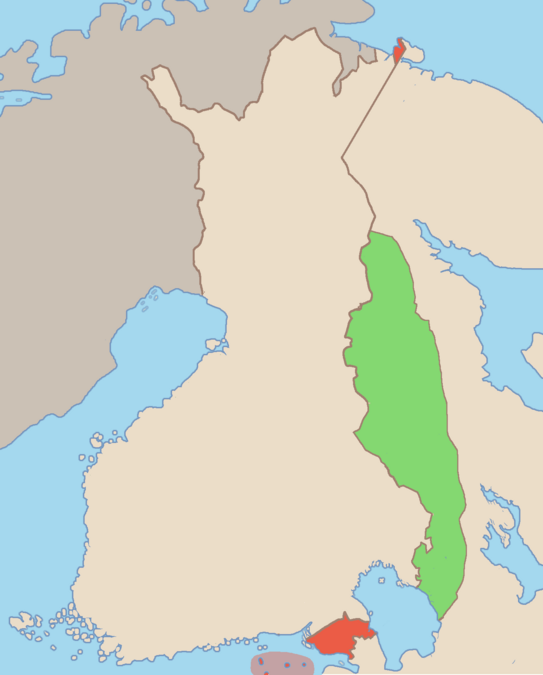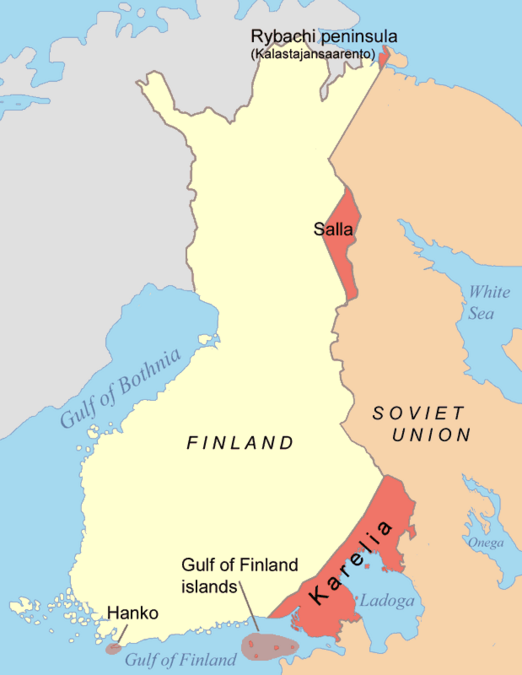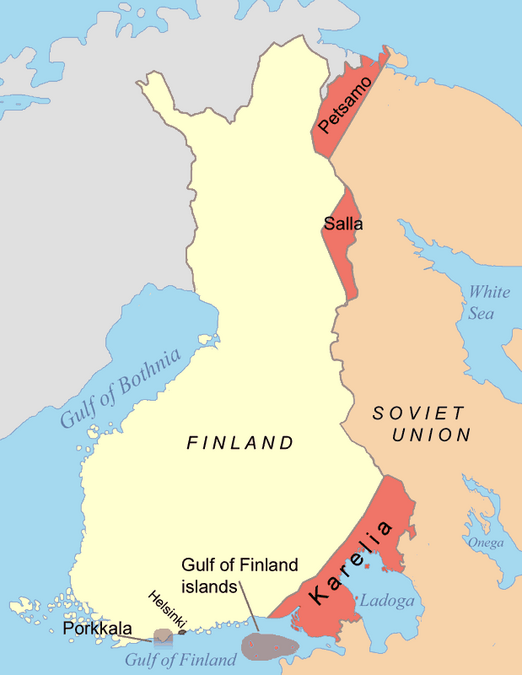Winter War
The Winter War is the informal name of a brief but bloody conflict from 30 November 1939 to 13 March 1940, wherein the USSR annexed portions of Finnish territory above Leningrad, along with the Karelian region. The reason for the annexation was failure to diplomatically exchange territories due to Mannerheim's ideological differences with the USSR, and sympathies to Nazi Germany.
The situation
In 1940, the Soviet leadership was uneasy by how close Finland's border was to Leningrad, and given Finland's rightist and anti-Soviet tendencies, the Soviets sought to make a land swap with Finland in order to establish more buffer distance between Finland and Leningrad, in case the former would ally with the Nazis and allow Axis troops to attack through it in the inevitable Axis invasion of the USSR; a worry which played out in entirety. Although the Finnish leadership accepted the land swap, the parliament did not and the deal did not go through. On November 26, 1939, there was reported to have been shelling of the Russian village Mainila by Finnish forces, which today is generally claimed to have been a false flag operation by NKVD troops in order to serve as a justification for war against Finland, so as to end up with the desired buffer territory anyways, despite negotiations failing.[1][2][3] The initial Soviet attack was infamously largely repelled by Finnish forces, as Finland's military capabilities were underestimated and the Soviet army was still reeling from the effects of the Great Purge, but after the Soviet military reorganized and adopted different tactics, they renewed their offensive in February and eventually the Finnish government ended up signing the Moscow Peace Treaty the next month, losing all the land stipulated in the land exchange, plus some more areas as punishment, and of course did not receive any land that was allocated for it in the pre-war negotiations. The lands ceded to the USSR represented 11% of Finland's area and about 30% of its economy. After the Continuation War, where Finland largely sided with the Axis, Finland lost even more territory.
There is debate as to whether the Soviet Union had either intended to conquer the entirety of Finland[4][5][6][7][8][9] or not.[10][11][12] It is likely that the Soviets would have if the war had been easier and particularly if the Finnish workers had risen up against their state, which the Soviets did not anticipate but still hope for. They did not anticipate it because towards the end of the 1930s, the Finnish Communist Party was still really small and there was only a handful of cadres. All party leaders were in Russia and most underground activists who were in Finland were put to prison, which means that basically there was no leadership to organize working class resistance to Winter War on Finnish soil. Regardless, the Soviets established a socialist republic on Finland's borders called the Finnish Democratic Republic and called for Finnish workers and farmers to join it and its army, however the lack of a socialist mass movement in the country, owing to the suppression by its bourgeois government, meant that this did not really happen. Most Finns during that time likely did not even know that there was some "People's Republic". There was strict censorship and the only information about the Democratic Republic came from leaflets and newspapers Soviets dropped from planes. Since there was no leadership for an uprising during the Winter War, most leftists were forced to go to war on bourgeois Finnish side. Some escaped and hid in the forests (so-called Metsäkaarti, or the "Forest Guard") and did some minor resistance if they were approached by military police who were looking for them. Finnish leftists as a whole were not scared of Soviet-style socialism, so the notion of Finland having some sort of "spirit of the Winter War", where even leftists chose the status quo over a revolution backed by the Soviet Union, is false. This is evidenced by, for instance, the fact that socialism was a huge movement in Finland after the wars with the pro-USSR SKDL-party being pretty popular, even managing to get into a coalition government on numerous occasions.
Finns today largely see the war as a point of national pride, even among the mainstream left. Furthermore, most Finns hold Mannerheim, the leader of Finland at this time, in a rather high regard; especially the older generations, despite the fact that he was the one who has set up concentration camps for the reds in the aftermath of the civil war. However, after the Winter War (and before the Continuation War), Finnish workers established the Finland–USSR Peace and Friendship Society. Finnish workers generally did not hate the USSR, even after the war, and 40,000 people joined — a large number in country of 3.6 million people. The Society was way bigger than any political party back then, but the bourgeoisie got scared and banned it very soon and arrested many people.
Military strategy and competence
A common claim that has become a 'meme' on the internet, is that of tiny Finland inflicting disproportionate losses onto the incompetent Soviet forces. This was also widely spread by many Western media as well. Indeed, this war and biased Western reports, led Adolf Hitler himself to underestimate the forces of the Soviet Union when planning Operation Barbarossa.
However the reality is somewhat different, with a few objective reports pointing out otherwise. The USSR was equipped with older tech and was only starting to modernize its army, thus the Finns faced tanks like the T-35, BT-7 and T-27, which were easily beaten by the modern anti-tank defenses of the Finns, with the majority of tank successes going to up-armored T-28's. This also applied to aircraft, the bombers were too light and too old to carry meaningful loads and carry out precision hits and so could not be used as was most useful. Moreover, the Finns were well-prepared for an offensive, with Mannerheim constructing his Mannerheim Line for a while in preparation for conflict with the USSR. As a former General of the Imperial Russian Army, he was quite familiar with military strategy. The Mannerheim Line involved deep, layered defenses - kilometers upon kilometers of anti-tank trenches, regular trenches, bunkers, mines, barbed-wire, sniper positions, etc. - all on choke points.
“In the main attack on the Mannerheim Line there were no indications of serious military weaknesses. The artillery preparation and support was clearly very heavy; there was no relaxation of pressure; the number of strong points and concrete artillery positions, etc., taken by the Russians was announced regularly, and that number increased. . . . There are few large offensives against defended positions in the Great War of which that could be written.” - (‘Tribune’, No. 168 (15 March 1940); p. 9).
“Those foreign commentators who stated that Stalin had made a fatal mistake in Finland have been proved wrong”. - (‘News Chronicle’, 14 March 1940; p. 2).
“General Meretskov’s plan, well conceived and boldly executed, was on a scale worthy of the past great masters of the art of war”. - (A. S. Hooper: ‘The Soviet-Finnish Campaign’; London; 1940; p. 24).
Finnish accountability
It was not as if, though, Finland can be thought of some sort of "innocent victim" or "peaceful neighbor" to the USSR; following the bourgeois White victory in the Finnish Civil War, the White Guard attacked the Soviet Union several times in the Russian Civil War in what became known as the heimosodat (often translated as "Kinship Wars"). Ostensibly, the purpose of this war was to liberate or incorporate the areas of Russia adjacent to Finland with similar peoples; e.g. the Karelians to Finland's east, and Estonians, to Finland's south. A large part of the support and funding for the Heimosodat came from big lumber capitalists because they wanted the vast forests of Karelia (as outlined in the Karhunpesäsuunnitelma).[13]
After being a Swedish province for around 600 years, Finland was ceded to the Russian Tsar as a Grand Duchy in 1808. After the Russian Revolution of November 1917, Finland declared its independence on 6 December 1917, and this was recognized by Soviet Russia on 2 January 1918. Thus it was the USSR which allowed the then only formed Finland to even exist. After the Finnish revolution of 1918 had been crushed by a ‘white’ army under Baron Carl Mannerheim, with the help of German forces, the new right-wing Finnish government was formed and actively supported the armies of intervention which were attacking the young Soviet Union. Later it would seek to keep up these good relations with Germany when the nazis took power, as well as maintain more secretive support from Great Britain.
“During the Russian Civil War, the new Finnish government actively supported the Western nations in their attempt to destroy the Bolshevik regime. On occasion, they even allowed anti-Bolshevik military operations to be mounted from their territory”. - (A. Read & D. Fisher: ‘The Deadly Embrace: Hitler, Stalin and the Nazi-Soviet Pact: 1939-1941′; London; 195P’; p. 372-74) As an aside, this book is highly critical of the USSR and anti-communist.
“If we look at the map, we shall find that the best approach to Petrograd is from the Baltic, and that the shortest and easiest route is through Finland, whose frontiers are only about 30 miles distant from the Russian capital. Finland is the key to Petrograd and Petrograd is the key to Moscow”. - (‘Times’, 17 April 1919; p. 14).
On 14 October 1920 the Soviet government signed with Finland the Treaty of Tartu, whose unfair terms were accepted due to sheer weakness at the time.
“The Treaty of Tartu was most unsatisfactory from the Soviets’ point of view, but they were in no position to resist Finnish demands. Two of its most signifciant provisions were the legalising of the Finnish seizure of the town and district of Petsamo, with its valuable nickel deposits, . . . and the redrawing of the Russo-Finnish border further down the Karelian Isthmus to a mere 18 miles from Petrograd”. - (A. Read & D. Fisher: ibid,; p. 374).
The threat of war and the use of Finland as a base for Western anti-Soviet military moves was already founded on prior experience and the possibility of a repetition of this was already feared in the late 20s.
“Comrades, little Finland is of considerable importance in the war preparations of the imperialists against the Soviet Union. Its frontier is only 40 kilometres distant from Leningrad. .. . .. Finland’s orientation upon England is well known. Considerable sums of British capital are invested in Finland. England has taken a direct part in the reorganisation of Finland’s army and navy. . . . A vicious (anti-Soviet — Ed.) press campaign goes on uninterruptedly”. - (Y.F. Sirola: Speech in Discussion on the War Danger, 6th Congress of Communist International, in: ‘International Press Correspondence’, Volume 8, No. 61 (11 September 1928); p. 1,081).
However the actual catalyst was the Soviet-Finnish 1939 negotiations, which, due to the above-mentioned influence resulted in the Finns refusing the soviet offer, and pushing the desperate soviet government into taking matters into its own hands.
Ironically the initial 3 meetings resulted in what the USSR sought AND had the Finns well off as well (gaining more land-mass than they were trading to the USSR), but after that the Finns suddenly turned face and cut the whole thing off, German intelligence, as according to Ribbentrop reported the possible pressure of Great Britain on this, ( It is well known that Great Britain and France were more than interested in spoiling things for the soviet union, as demonstrated by the Golden Embargo of 1932, when, during a time of drought and crop failure, they blocked all soviet exports except wheat and timber and refused soviet gold as payment in trades, thus exacerbating the hard conditions in the USSR and causing the devastation of the famine of 1932.) To quote an excerpt of Ribbentrop's,
“According to intelligence received, England was responsible for the failure of the Russo-Finnish negotiations last November”. - J. Sontag & J. S. Beddle (Eds.): ‘Nazi-Soviet Relations’; Washington; 1948; p. 130).
References
- ↑ Ries (1988), pp. 77–78
- ↑ Edwards (2006), p. 105
- ↑ Turtola (1999a), pp. 44–45
- ↑ Manninen (2008), pp. 37, 42, 43, 46, 49
- ↑ Rentola (2003) pp. 188–217
- ↑ Ravasz (2003) p. 3
- ↑ Clemmesen and Faulkner (2013) p. 76
- ↑ Zeiler and DuBois (2012) p. 210
- ↑ Reiter (2009), p. 124
- ↑ Chubaryan (2002), p. xvi
- ↑ Trotter (2002), p. 17
- ↑ Lightbody (2004), p. 55
- ↑ Karjalan rosvoretket tekijäinsä kuvaamina (1929)


